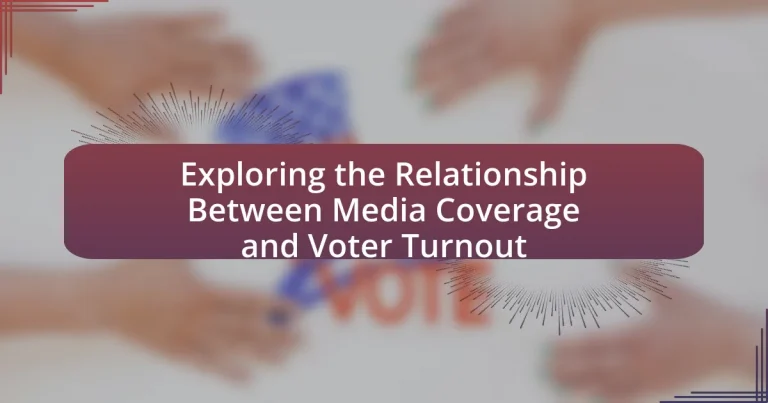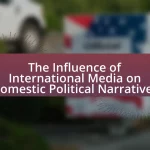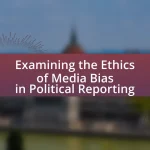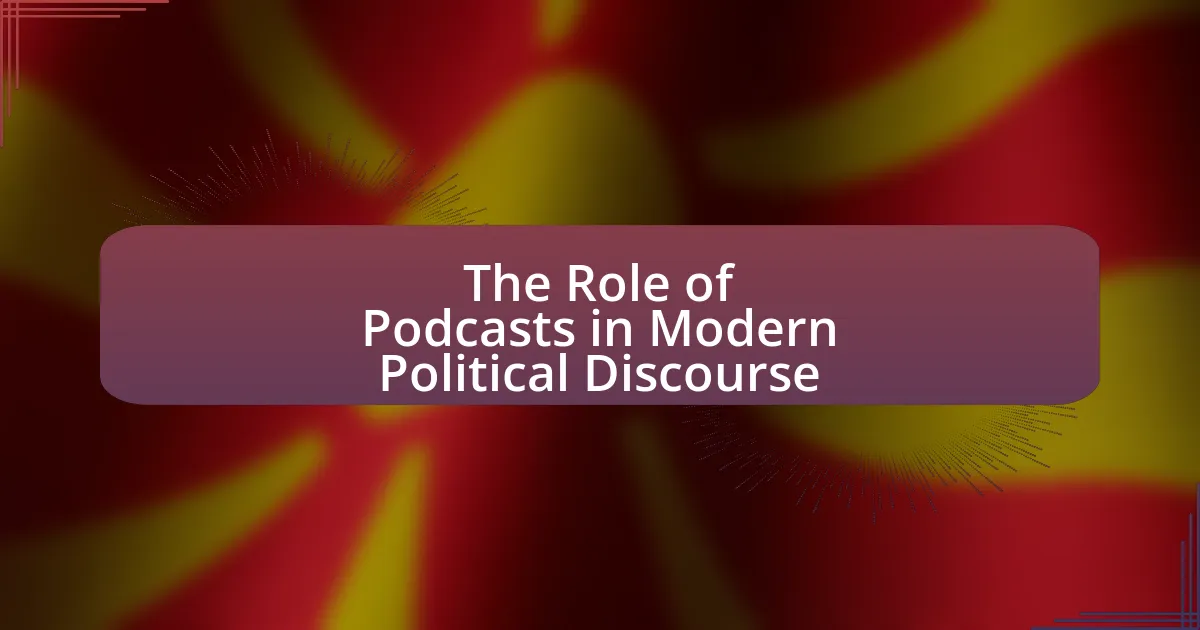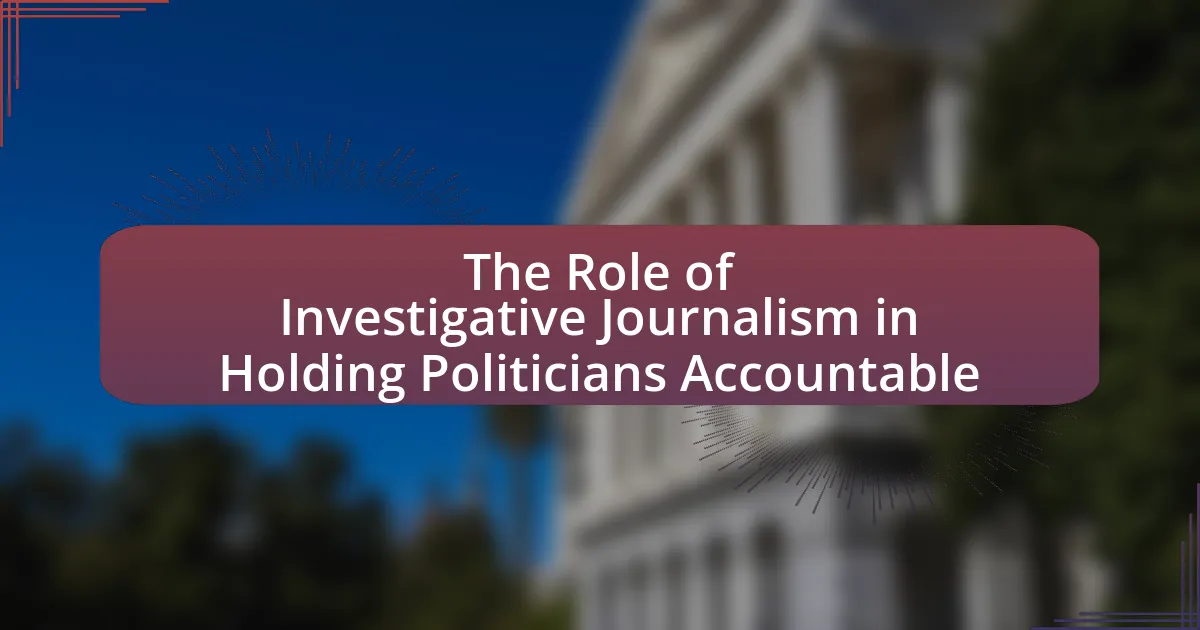The article examines the relationship between media coverage and voter turnout, highlighting how media influences public awareness and engagement in elections. It discusses the impact of various types of media coverage, including news reporting, political advertising, and social media, on voter participation rates. Key findings indicate that increased media exposure correlates with higher voter turnout, particularly when coverage is timely and credible. The article also explores demographic responses to media, the role of perceived bias, and strategies for optimizing media to enhance voter engagement, ultimately emphasizing the importance of effective media strategies in promoting democratic participation.
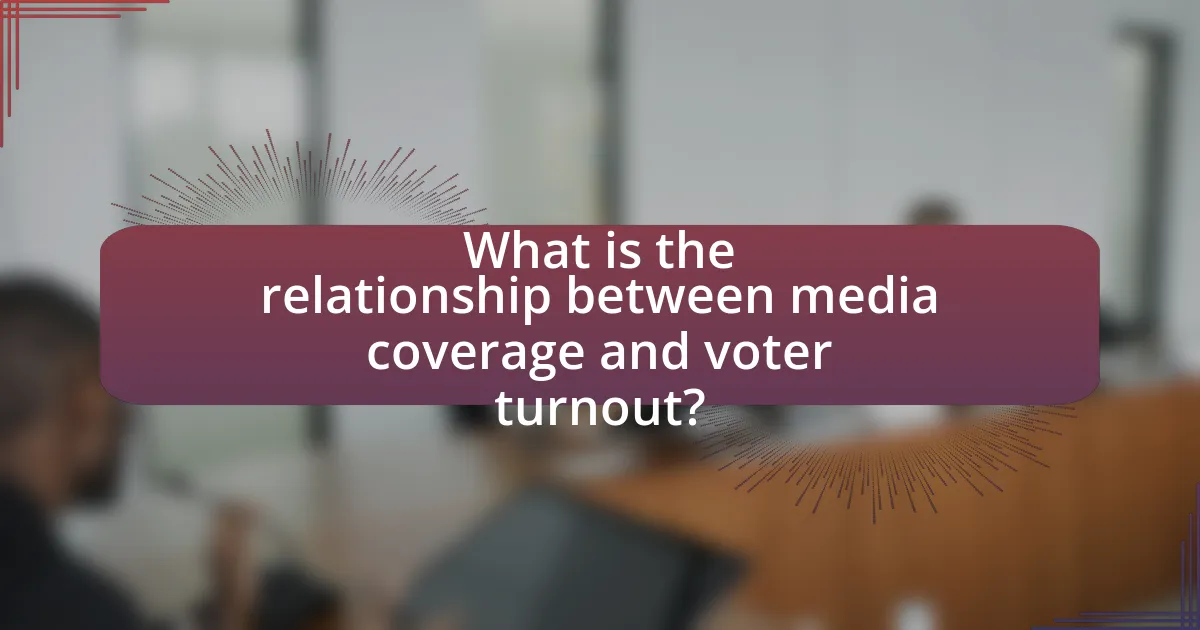
What is the relationship between media coverage and voter turnout?
Media coverage significantly influences voter turnout by shaping public awareness and engagement in elections. Studies indicate that increased media exposure correlates with higher voter participation rates, as comprehensive coverage informs citizens about candidates, issues, and voting logistics. For instance, research published in the Journal of Politics found that local news coverage of elections can increase turnout by as much as 5% to 10%, demonstrating the critical role media plays in mobilizing voters.
How does media coverage influence voter engagement?
Media coverage significantly influences voter engagement by shaping public perception and awareness of electoral issues and candidates. Research indicates that extensive media coverage can lead to increased voter turnout, as it informs citizens about the electoral process, highlights key issues, and provides insights into candidates’ positions. For instance, a study by the Pew Research Center found that 62% of voters reported that news coverage influenced their decision-making in the 2020 U.S. presidential election. This demonstrates that when media outlets prioritize political reporting, they enhance voter knowledge and motivation to participate in elections.
What types of media coverage are most impactful on voter turnout?
The types of media coverage that are most impactful on voter turnout include extensive news coverage, targeted political advertising, and social media engagement. Research indicates that when news outlets provide in-depth reporting on elections, including candidate debates and voter issues, it significantly increases public awareness and interest, leading to higher turnout rates. For instance, a study by the Pew Research Center found that 62% of voters reported that news coverage influenced their decision to vote in the 2020 election. Additionally, targeted political ads that resonate with specific demographics can mobilize voters by addressing their unique concerns, as evidenced by the effectiveness of micro-targeting strategies used in recent campaigns. Social media platforms also play a crucial role; a study published in the Journal of Communication highlighted that social media engagement can enhance voter mobilization efforts, particularly among younger voters, by fostering community discussions and sharing information about voting logistics.
How does the timing of media coverage affect voter decisions?
The timing of media coverage significantly influences voter decisions by shaping perceptions and information availability. For instance, research indicates that media coverage closer to election dates tends to have a more pronounced impact on voter behavior, as it provides timely information that can sway opinions and mobilize turnout. A study by the Pew Research Center found that 62% of voters reported that news coverage influenced their voting decisions, particularly when it occurred in the weeks leading up to an election. This suggests that timely media coverage can enhance voter engagement and affect the overall electoral outcome.
Why is understanding this relationship important for elections?
Understanding the relationship between media coverage and voter turnout is crucial for elections because it directly influences public engagement and participation in the electoral process. Research indicates that increased media coverage can lead to higher voter turnout, as it raises awareness about candidates and issues, thereby motivating individuals to vote. For instance, a study by the Pew Research Center found that 61% of voters reported that news coverage significantly impacted their decision to participate in elections. This demonstrates that effective media strategies can enhance democratic participation by informing and mobilizing the electorate.
What role does media play in shaping public perception of candidates?
Media plays a crucial role in shaping public perception of candidates by influencing how voters interpret their actions, policies, and character. Through various forms of coverage, including news articles, debates, and social media, media outlets can highlight specific narratives that either bolster or undermine a candidate’s image. For instance, studies have shown that candidates who receive positive media coverage tend to experience increased voter support, while negative coverage can lead to diminished public favorability. A notable example is the 2008 U.S. presidential election, where Barack Obama’s media portrayal significantly contributed to his appeal among younger voters, as evidenced by a Pew Research Center study indicating that 66% of young voters were influenced by social media in their voting decisions. Thus, the media not only informs the electorate but also actively shapes the perceptions that drive voter behavior.
How can media coverage affect voter motivation and participation?
Media coverage significantly influences voter motivation and participation by shaping public perception and awareness of electoral issues. When media outlets provide extensive coverage of elections, candidates, and key issues, they enhance voter knowledge and engagement, which can lead to increased turnout. For instance, a study by the Pew Research Center found that 61% of voters reported that news coverage influenced their decision to vote in the 2020 U.S. presidential election. Additionally, positive media portrayals of candidates can boost their appeal, while negative coverage can discourage voter support, ultimately affecting participation rates.

What factors contribute to the effectiveness of media coverage on voter turnout?
The effectiveness of media coverage on voter turnout is influenced by factors such as the frequency of coverage, the framing of issues, and the credibility of the media source. Frequent coverage increases awareness and engagement, as evidenced by studies showing that higher media exposure correlates with increased voter participation. The framing of issues can shape public perception and motivate voters; for instance, presenting voting as a civic duty can enhance turnout. Additionally, credible media sources foster trust, which is crucial for motivating individuals to participate in elections, as research indicates that trust in media correlates with higher voter engagement.
How do different demographics respond to media coverage?
Different demographics respond to media coverage in varied ways, influenced by factors such as age, race, education, and socioeconomic status. For instance, younger individuals often engage more with digital media, leading to higher responsiveness to online news and social media campaigns, while older demographics may rely on traditional media sources like television and newspapers. Research indicates that racial and ethnic minorities may perceive media coverage as biased or unrepresentative, affecting their trust and engagement levels. A study by the Pew Research Center found that 61% of Black Americans believe that news coverage does not accurately reflect their communities, which can impact their motivation to participate in voting. Additionally, individuals with higher education levels tend to seek out diverse media sources, resulting in a more nuanced understanding of issues, while those with lower education may rely on fewer sources, potentially leading to misinformation. These demographic differences highlight the importance of tailored media strategies to effectively engage various groups in the electoral process.
What are the differences in media consumption among various age groups?
Media consumption varies significantly among different age groups, with younger individuals favoring digital platforms while older generations prefer traditional media. For instance, a 2021 Pew Research Center study found that 95% of adults aged 18-29 use social media, compared to only 40% of those aged 65 and older. Additionally, adults aged 50 and above are more likely to watch television news, with 61% of this demographic relying on TV as their primary news source, while only 25% of those aged 18-29 do the same. This shift in media consumption reflects broader trends in technology adoption and content delivery preferences across age demographics.
How does socioeconomic status influence the impact of media on voter turnout?
Socioeconomic status significantly influences the impact of media on voter turnout by affecting access to information and engagement levels. Individuals with higher socioeconomic status typically have greater access to diverse media sources, which enhances their awareness of political issues and candidates, leading to increased voter participation. Conversely, those with lower socioeconomic status may rely on limited media exposure, often resulting in lower political efficacy and reduced turnout. Research indicates that in the 2020 U.S. presidential election, voters from higher-income households were 20% more likely to vote compared to those from lower-income households, highlighting the correlation between socioeconomic status, media access, and voter turnout.
What role does the credibility of media sources play?
The credibility of media sources plays a crucial role in shaping public perception and influencing voter turnout. Credible media sources provide accurate, reliable information that helps voters make informed decisions, thereby increasing engagement in the electoral process. Research indicates that when voters trust the media, they are more likely to participate in elections; for instance, a study by the Pew Research Center found that 62% of Americans believe that trustworthy news sources positively impact civic engagement. This correlation underscores the importance of media credibility in fostering an informed electorate, which is essential for a healthy democracy.
How does perceived bias in media affect voter trust and turnout?
Perceived bias in media significantly undermines voter trust and can lead to decreased voter turnout. When individuals believe that media outlets favor certain political perspectives, they may question the credibility of the information presented, which can diminish their confidence in the electoral process. Research indicates that voters who perceive media bias are less likely to participate in elections; for instance, a study by the Pew Research Center found that 70% of Americans believe news organizations favor one side, which correlates with lower engagement in voting activities. This skepticism can create a disengaged electorate, ultimately impacting the overall democratic process.
What are the implications of misinformation in media coverage?
Misinformation in media coverage significantly undermines public trust and distorts democratic processes. When voters receive inaccurate information, it can lead to misinformed decisions, ultimately affecting voter turnout and engagement. For instance, a study by the Pew Research Center found that 64% of Americans believe fabricated news stories cause confusion about basic facts, which can discourage participation in elections. Additionally, misinformation can create polarization, as individuals may gravitate towards sources that reinforce their biases, further alienating them from opposing viewpoints. This cycle of misinformation not only impacts individual voter behavior but also threatens the integrity of the electoral process itself.
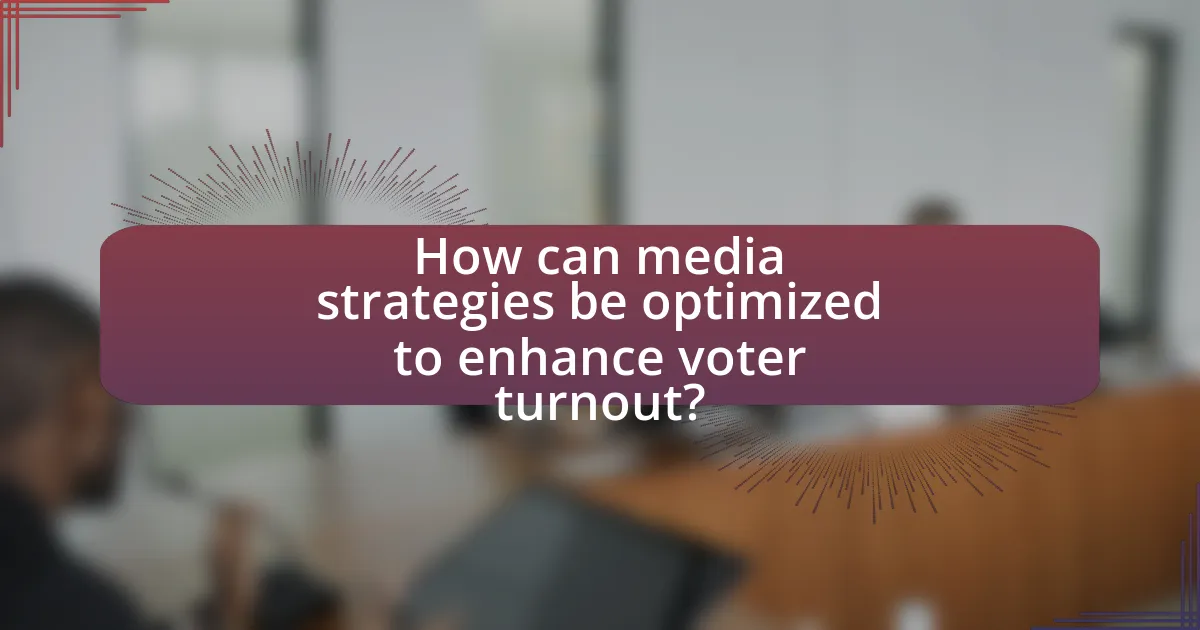
How can media strategies be optimized to enhance voter turnout?
Media strategies can be optimized to enhance voter turnout by utilizing targeted messaging and data analytics to engage specific demographics effectively. Research indicates that personalized communication, such as tailored advertisements and social media outreach, significantly increases voter engagement; for instance, a study by the Pew Research Center found that 69% of social media users reported being influenced by political content on these platforms. Additionally, employing a multi-channel approach that includes traditional media, digital platforms, and community outreach can create a comprehensive strategy that reaches voters where they are most active. This method has been shown to improve turnout rates, as evidenced by the 2018 midterm elections, where states that utilized diverse media strategies saw an increase in voter participation compared to those that relied solely on one medium.
What best practices should media outlets follow to engage voters?
Media outlets should prioritize accurate, timely, and accessible information to effectively engage voters. Providing clear and unbiased coverage of electoral processes, candidates, and issues fosters informed decision-making. Research indicates that media transparency and fact-checking enhance voter trust and participation; for instance, a study by the Pew Research Center found that 62% of voters rely on news media for election information. Additionally, utilizing diverse platforms, including social media, can reach a broader audience, as 53% of voters reported using social media for political information during the 2020 election cycle. Engaging voters through interactive content, such as polls and Q&A sessions, further encourages participation and dialogue.
How can media campaigns be tailored to specific voter demographics?
Media campaigns can be tailored to specific voter demographics by utilizing data analytics to understand the preferences, values, and behaviors of different groups. For instance, campaigns can segment voters based on age, ethnicity, and socioeconomic status, allowing for targeted messaging that resonates with each demographic’s unique concerns. Research indicates that personalized communication increases engagement; a study by the Pew Research Center found that 70% of voters respond positively to messages that reflect their specific interests and issues. By leveraging social media platforms and local media outlets that cater to particular demographics, campaigns can effectively reach and influence these groups, ultimately enhancing voter turnout.
What innovative approaches can be used to increase voter awareness through media?
Innovative approaches to increase voter awareness through media include utilizing social media campaigns, interactive online platforms, and targeted messaging. Social media campaigns can engage younger demographics effectively; for instance, platforms like Instagram and TikTok have been shown to increase political engagement among users aged 18-29, as evidenced by a study from the Pew Research Center in 2020, which found that 50% of young adults reported learning about political issues through social media. Interactive online platforms, such as voter registration websites that provide personalized information based on user location, can enhance user experience and increase participation. Targeted messaging, using data analytics to tailor content to specific demographics, can ensure that information resonates with diverse voter groups, thereby improving awareness and turnout.
What lessons can be learned from past elections regarding media coverage?
Past elections reveal that media coverage significantly influences voter turnout by shaping public perception and engagement. For instance, the 2008 U.S. presidential election demonstrated that extensive media coverage, particularly through social media platforms, mobilized younger voters, resulting in a turnout increase of 11% among those aged 18-29 compared to the previous election. Additionally, studies indicate that positive media framing of candidates correlates with higher voter enthusiasm and participation, as seen in the 2016 election where favorable coverage of certain candidates led to increased rally attendance and voter registration. These examples underscore the critical role of media in not only informing voters but also in energizing them to participate in the electoral process.
What case studies illustrate the impact of media on voter turnout?
Case studies that illustrate the impact of media on voter turnout include the 2008 U.S. presidential election and the 2016 Brexit referendum. In the 2008 election, extensive media coverage, particularly through social media platforms, significantly increased voter engagement, resulting in a turnout of approximately 61.6%, the highest for a presidential election since 1968. Research by the Pew Research Center indicated that 46% of voters reported that social media influenced their decision to vote. Similarly, during the 2016 Brexit referendum, targeted media campaigns, including advertisements and social media outreach, played a crucial role in mobilizing voters. The Electoral Commission reported a turnout of 72.2%, with media influence being a key factor in shaping public opinion and voter participation. These case studies demonstrate the direct correlation between media coverage and increased voter turnout.
How have changes in media technology influenced voter engagement strategies?
Changes in media technology have significantly influenced voter engagement strategies by enabling more targeted and interactive communication methods. The rise of social media platforms, for instance, allows political campaigns to reach specific demographics with tailored messages, increasing the likelihood of voter participation. According to a study by the Pew Research Center, 69% of adults in the U.S. use social media, which has become a crucial tool for mobilizing voters, particularly younger populations. Additionally, advancements in data analytics have allowed campaigns to analyze voter behavior and preferences more effectively, leading to more personalized outreach efforts. This shift towards digital engagement has transformed traditional methods, making voter outreach more efficient and impactful.
What practical steps can organizations take to leverage media for higher voter turnout?
Organizations can leverage media for higher voter turnout by implementing targeted communication strategies that engage and inform potential voters. These strategies include utilizing social media platforms to disseminate information about voting dates, locations, and procedures, which has been shown to increase voter awareness and participation. For instance, a study by the Pew Research Center found that 69% of adults in the U.S. use social media, making it an effective channel for reaching a broad audience.
Additionally, organizations can collaborate with local media outlets to promote voter registration drives and public service announcements that emphasize the importance of voting. Research from the National Bureau of Economic Research indicates that media campaigns can significantly influence voter turnout, particularly in underrepresented communities.
Furthermore, organizations should create engaging content, such as videos and infographics, that simplifies complex voting information and encourages sharing among users. This approach not only enhances understanding but also fosters a sense of community involvement, as evidenced by the increase in voter turnout during the 2020 U.S. elections, where digital engagement played a crucial role.
By focusing on these practical steps, organizations can effectively utilize media to enhance voter turnout and ensure that more voices are heard in the electoral process.
